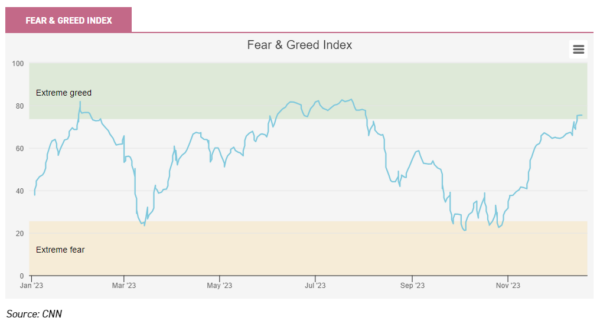Dec
2023
Is greed good?
DIY Investor
22 December 2023
With the Fear and Greed Index ending the year on a high, is investor optimism justified?…by Jo Groves
It may be a well-worn cliché but the last two years have proved somewhat of a rollercoaster for even the most level-headed of investors. Last year, 2022, saw fearful investors taking sanctuary in FTSE 100 stalwarts when growth stocks went into freefall, but it was all change again in 2023 as investors piled back into soaring tech stocks.
This behaviour, however, would have come as little surprise to Warren Buffett who observed: “Occasional outbreaks of those two super-contagious diseases, fear and greed, will forever occur in the investment community. The timing of these epidemics will be unpredictable.”
The Fear and Greed Index, developed by CNN, aims to quantify the unquantifiable: the emotional state of investors. The index is based on seven indicators, including the momentum and volatility of the S&P 500, the put/call ratio, and ‘safe haven’ demand for bonds, and tracks current deviations against long-term averages. These factors are combined into a score from 0 to 100, with 0 being maximum fear and 100 representing maximum greed.
The theory behind the index is that investor sentiment is a useful bellwether of future market movements, with an abundance of fear driving down stock prices while heightened greed can help to fuel a bull run in equities.
At this point it’s probably worth mentioning the ‘chicken and egg’ debate of causality: which comes first, positive investor sentiment or rising stock prices? Analysis of the data suggests that the Fear and Greed Index typically rises and falls broadly in line with, but slightly ahead of, the S&P 500, with a few notable exceptions.
One such occasion was in the second half of 2021 when the index remained largely in fear territory while the S&P 500 continued to rise. Was this an early warning sign that the bull run would shift into reverse and trigger a rout in growth stocks? Quite possibly but, either way, it shows the logic of incorporating an assessment of investor sentiment into a broader evaluation of market opportunities.
Coming back to the present, investor sentiment has swung from extreme fear towards extreme greed on a regular basis over the last year, as shown by the chart below. The recent improvement in investor sentiment has undoubtedly played its part in the ‘everything rally’ in US stock markets over the last few weeks. We’ve seen the small-cap Russell 2000 Index soar by more than 5% In the last week alone, while the larger-cap Nasdaq 100 hit an all-time high of more than 16,600 (as at 18/12/2023).

With the index heading upwards once more, investors might be asking whether greed is good (to plagiarise the line memorably delivered by smooth-talking corporate raider Gordon Gecko in the film “Wall Street”) or should they be more fearful of danger ahead for US equities?
At this point, it’s worth coming back to the basics. Index valuations remain subdued relative to their 10-year average and, despite the c. 50% year-to-date return in the Nasdaq 100, investors will be back to only slightly above break-even after its 33% fall in 2022.
Investor optimism may also be supported by signs of an improving macroeconomic backdrop as we head into the new year. In contrast to the ‘higher for longer’ narrative of the last few months, recent comments from the Fed appear to have pivoted from hawkish to more dovish, fuelling hope that rate cuts might be forthcoming sooner than originally anticipated. This could prove a tailwind for US equities, particularly for small-caps which tend to perform well when inflation and inflation cycles peak and start to fall.
With this in mind, Brown Advisory US Smaller Companies (BASC) provides exposure to the long-term growth opportunities of US small-caps, with a focus on quality growth companies. Manager Chris Berrier highlights the widening valuation gap between small-caps and large-caps in the US, providing opportunities for active fund managers to invest at attractive valuations.
Despite challenging market conditions, BASC has achieved a one-year share price return of 7.6% and is currently trading on a discount of -12.3% (as at 18/12/2023). Given that US small-caps have, on average, outperformed large-caps over time, this may provide an appealing entry point for investors, although investors should be cognisant of the risks associated with investing in small-caps.
Alternatively, JPMorgan American (JAM) offers investors a core exposure to US large-caps. The trust has a distinctive investment strategy, with two fund managers selecting stocks, one with a growth style and the other with a value focus.
This blended strategy has proved successful through cyclical rotations between value and growth styles over the last three years. JAM is the top performer in the IT North America sector over one and three years, delivering a share price total return of 26.4% and 53.5% respectively (as at 18/12/2023).
Given the shortening in market cycles over the past three years, it’s not surprising that investors have experienced similarly wild swings in sentiment. There is no guarantee that macroeconomic challenges will ease next year, however, investor optimism may well signal brighter times ahead for equity investors.

Disclaimer
This is not substantive investment research or a research recommendation, as it does not constitute substantive research or analysis. This material should be considered as general market commentary.
Leave a Reply
You must be logged in to post a comment.